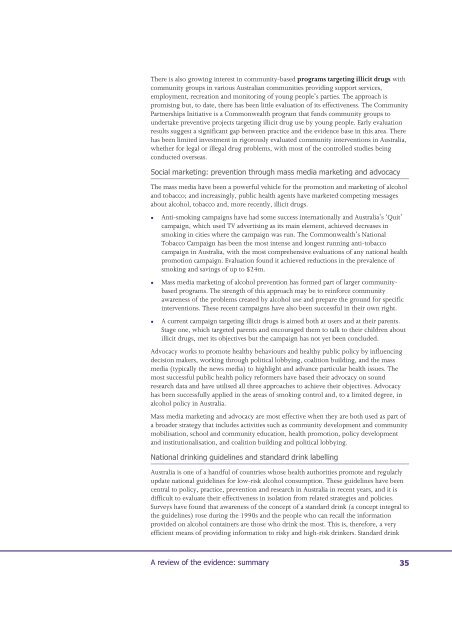Summary - Department of Health and Ageing
Summary - Department of Health and Ageing
Summary - Department of Health and Ageing
Create successful ePaper yourself
Turn your PDF publications into a flip-book with our unique Google optimized e-Paper software.
There is also growing interest in community-based programs targeting illicit drugs with<br />
community groups in various Australian communities providing support services,<br />
employment, recreation <strong>and</strong> monitoring <strong>of</strong> young people’s parties. The approach is<br />
promising but, to date, there has been little evaluation <strong>of</strong> its effectiveness. The Community<br />
Partnerships Initiative is a Commonwealth program that funds community groups to<br />
undertake preventive projects targeting illicit drug use by young people. Early evaluation<br />
results suggest a significant gap between practice <strong>and</strong> the evidence base in this area. There<br />
has been limited investment in rigorously evaluated community interventions in Australia,<br />
whether for legal or illegal drug problems, with most <strong>of</strong> the controlled studies being<br />
conducted overseas.<br />
<br />
The mass media have been a powerful vehicle for the promotion <strong>and</strong> marketing <strong>of</strong> alcohol<br />
<strong>and</strong> tobacco; <strong>and</strong> increasingly, public health agents have marketed competing messages<br />
about alcohol, tobacco <strong>and</strong>, more recently, illicit drugs.<br />
<br />
<br />
Anti-smoking campaigns have had some success internationally <strong>and</strong> Australia’s ‘Quit’<br />
campaign, which used TV advertising as its main element, achieved decreases in<br />
smoking in cities where the campaign was run. The Commonwealth’s National<br />
Tobacco Campaign has been the most intense <strong>and</strong> longest running anti-tobacco<br />
campaign in Australia, with the most comprehensive evaluations <strong>of</strong> any national health<br />
promotion campaign. Evaluation found it achieved reductions in the prevalence <strong>of</strong><br />
smoking <strong>and</strong> savings <strong>of</strong> up to $24m.<br />
Mass media marketing <strong>of</strong> alcohol prevention has formed part <strong>of</strong> larger communitybased<br />
programs. The strength <strong>of</strong> this approach may be to reinforce community<br />
awareness <strong>of</strong> the problems created by alcohol use <strong>and</strong> prepare the ground for specific<br />
interventions. These recent campaigns have also been successful in their own right.<br />
A current campaign targeting illicit drugs is aimed both at users <strong>and</strong> at their parents.<br />
Stage one, which targeted parents <strong>and</strong> encouraged them to talk to their children about<br />
illicit drugs, met its objectives but the campaign has not yet been concluded.<br />
Advocacy works to promote healthy behaviours <strong>and</strong> healthy public policy by influencing<br />
decision makers, working through political lobbying, coalition building, <strong>and</strong> the mass<br />
media (typically the news media) to highlight <strong>and</strong> advance particular health issues. The<br />
most successful public health policy reformers have based their advocacy on sound<br />
research data <strong>and</strong> have utilised all three approaches to achieve their objectives. Advocacy<br />
has been successfully applied in the areas <strong>of</strong> smoking control <strong>and</strong>, to a limited degree, in<br />
alcohol policy in Australia.<br />
Mass media marketing <strong>and</strong> advocacy are most effective when they are both used as part <strong>of</strong><br />
a broader strategy that includes activities such as community development <strong>and</strong> community<br />
mobilisation, school <strong>and</strong> community education, health promotion, policy development<br />
<strong>and</strong> institutionalisation, <strong>and</strong> coalition building <strong>and</strong> political lobbying.<br />
<br />
Australia is one <strong>of</strong> a h<strong>and</strong>ful <strong>of</strong> countries whose health authorities promote <strong>and</strong> regularly<br />
update national guidelines for low-risk alcohol consumption. These guidelines have been<br />
central to policy, practice, prevention <strong>and</strong> research in Australia in recent years, <strong>and</strong> it is<br />
difficult to evaluate their effectiveness in isolation from related strategies <strong>and</strong> policies.<br />
Surveys have found that awareness <strong>of</strong> the concept <strong>of</strong> a st<strong>and</strong>ard drink (a concept integral to<br />
the guidelines) rose during the 1990s <strong>and</strong> the people who can recall the information<br />
provided on alcohol containers are those who drink the most. This is, therefore, a very<br />
efficient means <strong>of</strong> providing information to risky <strong>and</strong> high-risk drinkers. St<strong>and</strong>ard drink

















